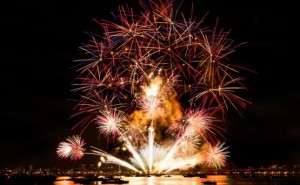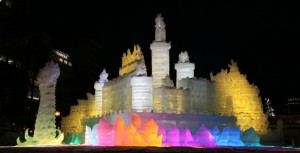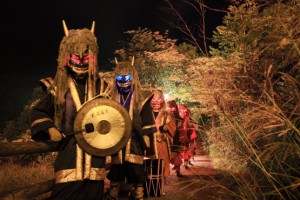
Festivals and Holidays
Great part of Japanese archipelago is in climate zone. A number of festivals are connected with the change of the seasons. Accordingly, festivals and holidays make journey unforgettable throughout Japan. There are festivals almost every day in each season and in each part of the country. Below you can see the main Japanese festivals and holidays:
Spring-period of plum and sakura blossoming
Beginning from the first days of March when plum begins blossoming, and till the end of May, when the last cherry leaves begin falling in the northern regions, spring wakes up the nature and makes people happy. Spring in Japan mainly means blossoming of some trees. In spring you can see beautiful variety of wonderful flowers. Especially camellia, iris, lotuses and mustards are lushly blossoming. Everywhere a lot of festivals are taking place.
March 1-14
Omijutori or water blessing ceremony, Todaiji temple, Nara
The ceremony is very impressive. It takes place under the light of pine torches and ends in the evening of March 12.
March 3
Hina Matsuri or dolls festival
The festival is celebrated throughout the country. It is a family festival. In families where young girls wear rich ornament as traditional dolls.
March 13
Kasuga Matsuri Festival, Kasuga temple, Nara
During this festival the classic dances are shown. These dances are shown more than thousand years.
Half of March (during 15 days)
Second tournament of Sumo wrestlers, Osaka
April 1-30
Miyako Odori or cherry dance, Tokyo
These are Japanese traditional dances shown by «maiko»-the pupils of geishas.
April 8
Hana Matsuri or Flower Festival
This festival takes place in all Buddhist temples dedicated to the birth of Buddha.
April 14-15
Takayama Matsuri or the day of Hie temple, Takayama
It is a parade of great platforms-temples miniatures.
May 3-4
Hakata Dontaku, Fukuoka
This festival is dedicated to the legendary Gods. During this famous festival the parade is held with people sitting on the horses.
May 3-5
Air Snakes Battle, Hamamatsu
The battle art of great air snakes in order to make the snake to leave the rival.
May 5
National Day of Children
This festival is remarkable with the raising of colorful images of carps which are waving with the breeze of spring.
May 11
Fishing on Nagara river shore, Gifu (till October 15)
May 15
Aoi Matsuri or marshmallow festival, Kyoto
This festival is famous with its beautiful scenes.
Half of May (15 days continually)
Third tournament of Sumo wrestlers, Tokyo
Half of May
Kanda Matsuri or Kanda Myojine Festival (it is held on each odd year) During this festival march ceremony is held with a number of saint palanquins
May 17-18
General festival of Toshogu temple, Nikko
It is a remarkable march with the « mikosi (praying) » removable palanquins. More than thousand people participate in this festival.
Third Sunday of May
Mifune Matsuri on Oyi river shore, Kyoto
The parade of old boats is organized.
Third Sunday of May, preceding Friday and Saturday
Sanja Matsuri Festival of Asakusa temple
This festival is remarkable with the three big and more than one hundred little removable temples ceremony.
Summer-leisure period in nature
Summer is a period of rice cultivation. The whole country is covered with green grass. In mountainous forests the green leaves of cherry, maple, oak and chestnut are in contrast with the dark colors of evergreen pines and bamboo slim sprouts hardly appearing on the ground.
Summer is a season of fireworks. Almost every evening bright firework is made throughout Japan colorfully lightening the night sky.

In summer in each corner of the country a number of cheerful festivals are held. A lot of festivals are carried out accompanied by colorful national dances. These dances such as «Bon Odori» are wonderful way of leisure and recreation for local population, their friends and guests.
Half of June
Sano Matsuri, Hie temple, Tokyo
A parade is organized with removable temple on the lively streets of Akasaki region.This festival is held once every two years.
Second Saturday of June
Festival of Horses Chagu-Chagu-Umakko, Morioka It is a parade of beautifully decorated horses.
July 7
Tanabata National Festival or Stars Festival
This festival is luxuriously celebrated in Sendai city. During this festival bamboo roads are shown in front of house doors and garden gates. There are also colorful paper strips attached to these bamboo rods.
Half of July (15 days continually)
Fourth tournament f sumo wrestlers, Nagoya
July 13-15 (or August, depending on the country regions)
In the memory of the deaths of O-Bonn a religious ritual is held throughout the country.
The national dances are shown for pacifying the souls of «Bonn Odori» deaths.
July 14
Hi-Matsuri Festival, Nati temple
It is fire festival Nati-Katsuura. During this festival clergymen carry twelve big torches wearing in white.
July 1-15
Hakara Gion Yamagata Festival, Fukuoka
The end of the festival is the 15th of July. It is a march of great palanquins.
July 16-17
Gion Matsuri
It is a big festival in Kyoto. This festival was held even in the 9th century. Great, gorgeous decorated palanquins are carried on central city streets.
The last Saturday of July
It is a show of big firework on Samba River, Tokyo.
July or August
Kangensai Music Festival, Itsukushima temple, Hiroshima
During the festival dances are held accompanied by palace music.
July 24-25
Tenjin Matsuri festival or Temmangu temple festival, Osaka
It is a show of little miniature temples. They are carried on boats through Osaka streets.
August 1-7
Nebuta Matsuri Festival, Aomori (August 2-7), Neputa Matsuri Festival, Hirosaki (August 1-7)
It is a parade of great and bright images attached to the carts with wheels.
Ahgust 3-6
Kanto Matsuri Festival, Akita
This festival is famous with its big parade. During this festival the participants make equal the numerous pyramids of paper lanterns attached to the bamboo rods.
August 5-7
Hanagasa Matsuri Festival, Yamagata
During this festival nearly ten thousand people show national dances. They carry traditional hats on their heads. The hats are decorated with colorful made-up flowers.
August 12-15
Traditional Dance Festival, Tokushima
During this festival day and night you can hear song and dance voices.
August 16
Daimonji Bonfire
In this festival people make bonfire on the mountain surrounding Kyoto. This bonfire «Dai» (huge) has a hieroglyph view.
Autumn-period of harvest and fall of leaves
In many Japanese regions summer lasts till September. However, in October in many Japanese regions you can see bracing cold autumn days. Autumn in Japan brings changing mosaics of colorful leaves. Bright colors of leaves from crimson and gold to bronze and yellow make hills and mountains colorful. It is harvest period grain corns are gathered like pyramids or gathered on bars for further drying and cultivation. Autumn in Japan is a period of numerous festivals, sport competitions and cultural festivals. The festivals are held throughout the country.
September 16
Yabusame-shooting art festival sitting on horses
It takes place in Tsurugaoka Hachiman temple, Kamakura
Half of September (during 15 days)
Fifth tournament of sumo wrestlers, Tokyo
October 7-9
Kunti Festival, Suva temple, Nagasaki
It is festival showing dragon dance in Chinese style.
October 7-10
Takayama Matsuri Festival, Hachimangu temple
It is remarkable parade with colorful palanquins.
Half of October
City Festival in Nagoya city
It is a remarkable march on city streets. During this festival people wear feudal princes clothing.
October 14-15
Kenka Matsuri Festival or «Quarrelling Festival»
The festival takes place in Matsubara Shinto temple, Himeji the end of festival is the 15th of October.
Half of October and November
Chrysanthemums Festival, Meiji and Asakusa temple, Tokyo
October 17
Autumn Festival of Toshogu temple, Nikko
This tradition is connected with the saint palanquins processing. This festival is carried out accompanied by armed servants.
October 22
Jidai Matsuri Festival or «Festival of Era», Heian temple, Kyoto
It is one of three big festivals of Kyoto city.
October 22
Fire Festival Yuki, Kurama temple, Kyoto
During this festival the lanterns are arranged with a large row on the roads leading to temple.
November 2-4
O Kunti Festival, Karatsu temple, Saga
This festival is famous with beautiful parade of colorful palanquins.
November 3
Daimyo Gyoretsu Festival, Hakone
It is really presenting parade of past feudal leaders.
Half of November
Tori-no-iti Festival, Otori temple, Kanto
This is famous as national festival accompanied by fire.
Half of November (during 15 days)
Sixth tournament of sumo wrestlers, Fukuoka
November 15
Siti-go-san Festival
It is a festival of 3, 5 and 7 years old children. This day the children of these ages are taken to temple to thank God for having good health.
Winter-winter leisure period
Winter in Japan is not so severe, except the northern regions: usual autumn days and blue sky. Different festivals are held in the northern regions dedicated to snow and ice. Tourist as well as the natives admire snow and ice sculptures. They participate in festivals and ceremonies. A lot of festivals and fairs are held throughout the country in New Year Eve.
December 15-18
On-Matsuri Festival, Kasuga temple, Nara
During this festival a masquerade is organized.
December 17-19
Hagoita-ini (rocket fair) festival, Asakusa Kannon temple, Tokyo
December 31
Okera-Mairi Festival, Yasawa temple, Kyoto
Saint Fire Ceremony
December 31
Namahage ceremony, Oga peninsula, Akita
During this festival men knock the doors of those houses where live children.
January 1
New Year
From January 1-3 almost all offices, enterprises and companies are closed. The families celebrate New Yea. They make traditional dishes; wear the best kimonos or other festive clothing. They go Shinto or Buddhist temples, pray God for having health and happiness in the nest year.
January 6
Dedzomesiki
It is a Christmas parade of Tokyo firefighters. During this parade they perform acrobatic tricks standing at the highest point of fire stairs.
Half of January (during 15 days)
First tournament of sumo wrestlers, Tokyo
January 7 (during 7 days)
Winter Festival in Sapporo, Hokkaido
This is the most famous festival of Japan. It is a show of snow and ice sculptures.
Beginning or half of January
It is a festival held in Asahikawa, Abasir or in many cities of Hokkaido.

February 3 or 4
Setsubun (spring eve) or bean throwing festival
This festival is held in Japanese general temples.
February 3 or 4
Lanterns Festival, Kasuga temple, Nara
February 16-17
Bonden Festival, Yokote, Akita
Young people carry on them a lot of Bonden images as God creation symbols.
February 16-17
Kamakura Matsuri Festival, Yokote, Akita
During this festival in honor of God of Water snow houses are built.
Third Saturday of February
Edo Festival or Hadaka Matsuri (bare festival), Saidaiji temple, Okayama
Note: the information is based on the data of 2011. However, they could be changed.
NATIONAL HOLIDAYS
January 1-New Year (Christmas)
Second Monday of January-Adult Day
February 11-State Establishment Day
March 21 (20)-Spring day and night equality day
April 29-Greenery Day
May 3-Constitution Day
May 5-Children Protection Day
Third Monday of July-Sea Day Third Monday of September-Elders Day
September 23 (or 24)-Autumn day and night equality day
Second Monday of October-Health and Sport Day
November 3-Culture Day
November 23-Work Day
December 23 Emperor Birth Day
Note: As national holiday day is Sunday, so the next Monday becomes week-end. When week day (except Sunday) is between national holiday, this day also becomes weekend; for instance, May 4.
the material is taken from http://visitjapan.ru/japan/festivali-i-prazdniki/
translated from Armenian into English by Tatev Harutyunyan












